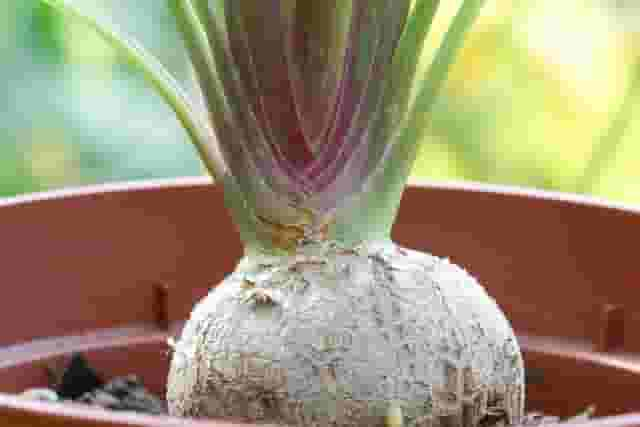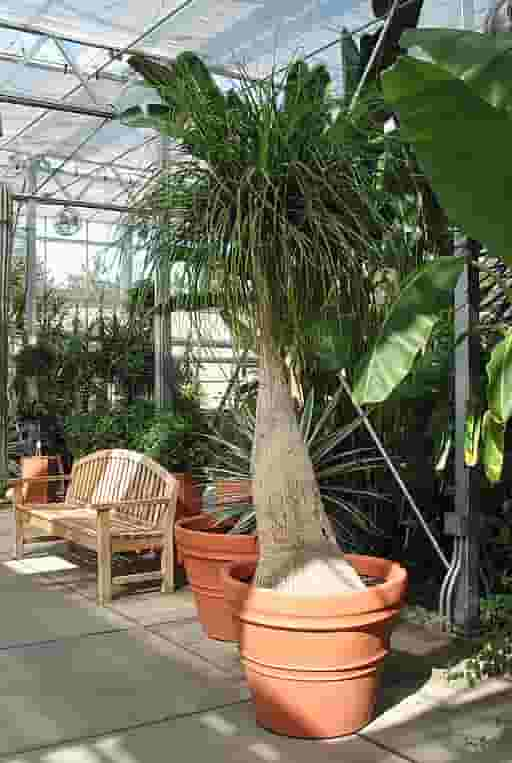परिचय
Are you looking to enhance the aesthetics of your indoor space with a unique and low-maintenance plant? Look no further than the ponytail palm (Beaucarnea recurvata). Also known as the elephant’s foot palm or bottle palm, this distinctive plant is a popular choice among plant enthusiasts. In this article, we will delve into the world of ponytail palms, exploring their characteristics, care requirements, and the benefits they bring to your indoor garden. So, let’s unravel the secrets of this captivating plant!
What is a Ponytail Palm?
Contrary to its name, the ponytail palm is not a true palm but a member of the Agave family. It is a unique, slow-growing succulent that hails from the arid regions of Mexico. The plant features a stout, swollen base that resembles an elephant’s foot, storing water to help it survive during periods of drought. The long, slender leaves arch and cascade downward, resembling a ponytail—hence its name.
The Unique Appearance of the Ponytail Palm
The ponytail palm boasts a striking appearance that sets it apart from other indoor plants. The most captivating feature is its swollen base, which can range in size from a few inches to several feet in diameter. This unique characteristic not only adds visual interest but also serves as a water reservoir, allowing the plant to thrive in dry conditions. From the base, long, narrow leaves emerge, gracefully arching and cascading down. These leaves, which can grow up to several feet in length, are dark green and have a slightly waxy texture.
Choosing the Right Spot
When it comes to positioning your ponytail palm, it’s important to consider its light and temperature requirements. This plant thrives in bright, indirect light, making it an excellent choice for well-lit indoor spaces. To prevent leaf scorching, it is advisable to avoid placing the ponytail palm in direct sunlight. As for temperature, the ponytail palm prefers a warm environment, ideally between 65°F and 85°F (18°C to 29°C). It can tolerate slightly lower temperatures but may suffer damage if exposed to freezing conditions.
Ponytail Palm Care and Maintenance

Light and Temperature Requirements
To ensure the healthy growth of your ponytail palm, provide it with bright, indirect light. Position the ponytail palm near a window facing south or west, allowing it to bask in a few hours of sunlight daily. If there is insufficient natural light available, you can enhance the ponytail palm’s lighting conditions by using artificial grow lights. Regarding temperature, maintain a warm environment within the recommended range mentioned earlier.
Watering and Humidity
One of the advantages of owning a ponytail palm is its ability to tolerate drought-like conditions. It is a succulent plant, and its base acts as a water reservoir. Allow the soil to partially dry out between waterings, making sure that the top few inches are dry before watering the ponytail palm again. Watering the ponytail palm excessively can result in root rot and various problems. Therefore, it is advisable to lean towards underwatering rather than overwatering to maintain optimal plant health. The ponytail palm thrives in average indoor humidity levels and doesn’t require additional humidity.
Soil and Fertilizer
Use well-draining soil to prevent waterlogging, as this can be detrimental to the plant’s health. A cactus or succulent potting mix works well for ponytail palms. During the growing season (spring and summer), feed the plant with a balanced, water-soluble fertilizer diluted to half strength. Apply the fertilizer once every two to three months to provide the necessary nutrients for healthy growth.
Pruning and Grooming
Ponytail palms are relatively low-maintenance plants when it comes to pruning. However, you may want to remove any yellowing or dead leaves to maintain the plant’s aesthetics. Use clean, sharp pruning shears and make clean cuts to avoid causing damage or introducing diseases.
Common Pests and Diseases
Fortunately, ponytail palms are not highly susceptible to pests or diseases. However, they may occasionally encounter issues such as mealybugs or spider mites. Monitor your plant regularly for signs of pests and take appropriate measures if an infestation occurs. Maintaining proper care practices, including avoiding overwatering, will help prevent many potential problems.
Tips for Troubleshooting
If your Ponytail Palm is not thriving as expected, consider the following troubleshooting tips:
- Adjust the lighting conditions: Ensure the plant receives sufficient but indirect light.
- Check watering practices: Avoid overwatering and allow the soil to dry out between waterings.
- Assess the temperature and humidity: Ensure the plant is not exposed to extreme temperature fluctuations or excessive dryness.
- Inspect for pests: Regularly inspect the plant for signs of pests and treat them accordingly.
Benefits of Having a Ponytail Palm
The ponytail palm offers several benefits that make it a popular choice among indoor plant enthusiasts:
- Air purification: Like other plants, the ponytail palm helps improve indoor air quality by removing toxins and releasing oxygen.
- Low maintenance: This plant requires minimal care and can withstand periods of neglect, making it an excellent choice for busy individuals or those new to plant care.
- Drought tolerance: The ponytail palm’s ability to store water in its base allows it to survive in arid conditions, making it an ideal plant for those who tend to forget to water regularly.
- Eye-catching aesthetics: With its unique swollen base and cascading leaves, the ponytail palm adds a touch of exotic beauty to any indoor space.
Adding Personality to Your Décor

The ponytail palm is not only an appealing houseplant but also an excellent addition to your home décor. Its distinct appearance can serve as a conversation starter and adds a touch of greenery to any room. Whether placed in a modern minimalist setting or a bohemian-inspired space, the ponytail palm brings a sense of personality and charm to your interior design.
निष्कर्ष
In conclusion, the ponytail palm is a fascinating and visually captivating plant that adds a touch of uniqueness to any indoor garden or living space. Its distinctive appearance, low-maintenance nature, and ability to thrive in dry conditions make it an ideal choice for both beginner and experienced plant enthusiasts. By following the care guidelines provided and incorporating a ponytail palm into your home décor, you can enjoy the beauty and benefits this remarkable plant brings. So, why wait? Embark on your journey of cultivating a ponytail palm and witness the enchantment it brings to your surroundings.
Frequently Asked Questions (FAQs)
Can I grow a ponytail palm outdoors?
Yes, the ponytail palm can be grown outdoors in regions with a warm and arid climate. However, it is more commonly cultivated as an indoor plant.
How often should I water my ponytail palm?
Water your ponytail palm when the top few inches of soil have dried out. To avoid overwatering, it is important to let the soil partially dry out between each watering session.
What should I do if my ponytail palm’s leaves turn brown?
If the leaves of your ponytail palm turn brown, it could be a sign of overwatering or insufficient light. Adjust your watering routine and ensure the plant receives enough indirect sunlight. Trim off any brown or dead leaves to maintain the plant’s health and appearance.
Does the ponytail palm require much sunlight?
While the ponytail palm prefers bright, indirect light, it can tolerate lower light conditions. However, insufficient light may cause slower growth and less vibrant foliage. Aim to provide the plant with several hours of sunlight each day for optimal growth.
Is the ponytail palm safe for pets?
The ponytail palm is generally considered non-toxic to pets. However, it’s always a good idea to monitor your pets around plants and seek veterinary advice if you suspect any unusual behavior or ingestion.

